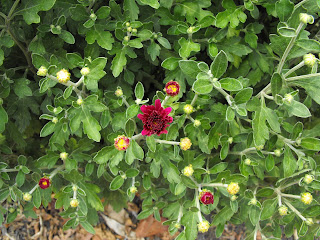Today marks the 3rd anniversary closing on the house at 410.
I stood in the backyard the next morning (picture by realtor, above), in complete awe of the bourgeois pleasure of property-ownership, and in complete elation of the blank garden slate that was mine.
 The grassy area on the right of the above photo marks the edges of what became the east side shade bed, which I thought would be an appropriate focus (on transformation and process) for this anniversary blog entry.
The grassy area on the right of the above photo marks the edges of what became the east side shade bed, which I thought would be an appropriate focus (on transformation and process) for this anniversary blog entry.There are those who think gardening involves putting plants in the ground and calling it a day. Joy evolves from watching those plants grow and fill the spaces into which they were thrust.
And there are those who reject that view as somehow anathema to the concept of gardening. Let's get grammatical for a moment. Gardening, to be technical, is the present participle of the verb “to garden,” and therefore speaks to an activity or a process—perhaps without end. Gardening is about transformation—of design, of plantings, of arrangements, and of self. I consider myself part of this crowd. The east side shade bed illustrates.
 We devoted the first year in the house to interior sorts of projects. By the spring of 2008, I was ready to begin gardening (see above photo). I soon discovered that the ground on which 410 sat consisted of dense, heavily compacted, bedrock quality clay. And so began the task of digging out by hand what would become the east side shade bed: one foot down, 7 feet in width, and 16 feet in length. (And why did I not rent a rototiller?) After working into the soil approximately 800 pounds of manure (which I have discovered was not nearly enough), I began planting thanks to the generosity of friends Jim and Patricia, and Phyllis, about whom I wrote in an earlier entry.
We devoted the first year in the house to interior sorts of projects. By the spring of 2008, I was ready to begin gardening (see above photo). I soon discovered that the ground on which 410 sat consisted of dense, heavily compacted, bedrock quality clay. And so began the task of digging out by hand what would become the east side shade bed: one foot down, 7 feet in width, and 16 feet in length. (And why did I not rent a rototiller?) After working into the soil approximately 800 pounds of manure (which I have discovered was not nearly enough), I began planting thanks to the generosity of friends Jim and Patricia, and Phyllis, about whom I wrote in an earlier entry. In 2009, Viet and I purchased 2 palletes of rock, removed the concrete walkway and patio, and constructed stone walls around the beds. I re-shaped the east side shade bed, and created a new, Buddha Bed, which I then connected to the existing bed with a small ‘isthmus’ in which I planted European ginger and Lady’s Mantle, which Gramsci decided he did not like and so, consequently, over-watered.
 This year, I introduced a few new plants into the east side bed—Corydalis flexuousa, Big Blue hosta, Petasites japonicus, a Tassel Fern, and Ligularia Britt-Marie Crawford—but am increasingly convinced that the central area of the bed needs redesign. One hosta simply doesn't like its current situation; the Tassel Fern was soon overtaken by one of the hostas; and I am frankly tired of the ostrich ferns (at least those in the middle, all of which are now beginning to aestivate, while the ones more protected from the harsh sun are 'holding their own'). The Nikko Blue Hydrangea is feeling rather blue (and not in a good way) since the winter storms took down one of the largest evergreens in the neighbor's yard--the very one that shaded the hydrangea from the late morning and early afternoon sun. The poor thing droops each day, and I must douse it with a bucket of water to keep it properly hydrated.
This year, I introduced a few new plants into the east side bed—Corydalis flexuousa, Big Blue hosta, Petasites japonicus, a Tassel Fern, and Ligularia Britt-Marie Crawford—but am increasingly convinced that the central area of the bed needs redesign. One hosta simply doesn't like its current situation; the Tassel Fern was soon overtaken by one of the hostas; and I am frankly tired of the ostrich ferns (at least those in the middle, all of which are now beginning to aestivate, while the ones more protected from the harsh sun are 'holding their own'). The Nikko Blue Hydrangea is feeling rather blue (and not in a good way) since the winter storms took down one of the largest evergreens in the neighbor's yard--the very one that shaded the hydrangea from the late morning and early afternoon sun. The poor thing droops each day, and I must douse it with a bucket of water to keep it properly hydrated. But that renovation will have to wait until early next spring. Already the projects line up, and I look forward not to enjoying the remainder of this sweltering summer, but to next year and all the things that can, and must, be done.
But that renovation will have to wait until early next spring. Already the projects line up, and I look forward not to enjoying the remainder of this sweltering summer, but to next year and all the things that can, and must, be done.Good thing, as we face another 27 years of mortgage!



































